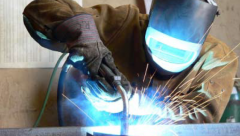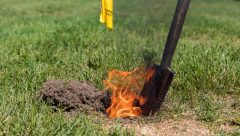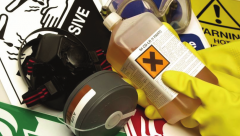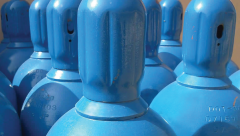By Jerome E. Spear, CIH, CSP, FAIHA Heinrich’s study in 1931 concluded that for every serious injury, about 29 minorinjuries occur with 300 other occurrences that produce no injury (Heinrich 90). In anotherstudy, Bird and Germaine showed a 500:100:1 relationship among property-damageaccidents, minor-injury accidents, and disabling injury accidents (Bird and Germain 21).Fletcher reported a ratio…
By Jerome E. Spear, CSP, CIH Chromium has been used commercially in the U.S. for more than 100 years. Chromium occurs mainly in three forms, described by its valence state. Metallic chromium (Cr[0]) is a steel-gray solid with a high melting point that is used to make steel and other alloys. Chromium metal does not…
By Jerome E. Spear, CIH, CSP, FAIHA When the National Science Foundation’s Office of Polar Programs organizes a team to travel to the Antarctica to drill ice cores, preparations are extreme. Drillers wear tight cuff wet gear over extremely cold weather gear as well as gloves, hoods, cold weather face masks and chemical vapor respirators.…
By Jerome E. Spear, CIH, CSP, FAIHA The use of lift trucks powered by internal combustion engines inside buildings and enclosed spaces creates the potential buildup of carbon monoxide (CO). Propane-powered (LPG) lift trucks represent 60% of all material handling vehicles and 80% of all internal combustion lift trucks. Although LPG lift trucks emit considerably…
By Alexander Ritchie and Georg Marcum Whether a company utilizes a fleet of trucks or has just one commercial vehicle, the anticipation of a Department of Transportation (DOT) safety compliance audit can be a nerve-wracking experience – if you are not prepared. The best way to pass a DOT audit is to be certain that…
By Jerome E. Spear, CIH, CSP, FAIHA and Alexander Ritchie The possibilities of damaging underground utilities exist at every drilling site. Inadvertently severing an underground power line, rupturing a natural gas line, or damaging other underground utilities can result in significant consequences in terms of disrupting essential services, costly repairs, downtime, and potentially serious injuries…
OSHA’s Adoption of the Globally System of Classification and Labeling of Chemicals (GHS) By Jerome E. Spear, CIH, CSP, FAIHA Laws and regulations throughout the world are different enough to require multiple labels and safety data sheets for the same product both within the U.S. and international trade. It is estimated that about 42 to…
Compressed gases pose a unique hazard. Depending on the particular and mechanical hazards associated with high pressure as well as chemical hazards associated with the gas itself. As a result, gas cylinders require special storage and handling precautions. Compressed gas and equipment is addressed in specific OSHA standards for both general industry and the construction…
OSHA requires exposures to hexavalent chromium (Cr[VI]) above the permissible exposure limit (PEL) of 5 micrograms per cubic meter (μg/m³) to be reduced using feasible engineering controls, which is consistent with other substance-specific standards and good industrial hygiene practice. If feasible engineering controls do not sufficiently reduce exposures to below the PEL, exposures must be…
By Jerome E. Spear, CSP, CIH, FAIHA How an organization measures performance undoubtedly influences organizational behavior. However, measuring safety is difficult because it is difficult to predict the impact that new safety metrics will have on individual behavior, attitudes, and the overall safety climate. Regardless of how difficult it is to measure, a firm’s safety…











